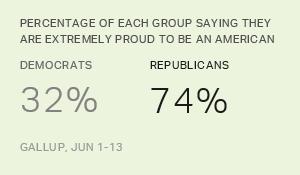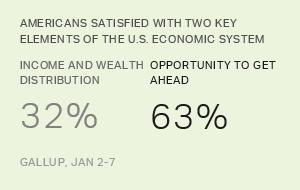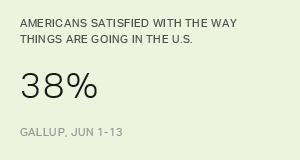Story Highlights
- 55% say America's best days are ahead, up from 47% in 2012
- 41% say the country's best days are in the past, down from 50%
- Republicans more likely than Democrats to say best days are ahead
WASHINGTON, D.C. -- Fifty-five percent of U.S. adults believe the United States' best days are "ahead of us," while 41% say they are "behind us." Americans are more optimistic about the country's future than they were the last time Gallup polled on the question, in December 2012, when Americans were nearly evenly split in their views.
| Ahead of us | Behind us | No opinion | |||||||||||||||||||||||||||||||||||||||||||||||||||||||||||||||||||||||||||||||||||||||||||||||||
|---|---|---|---|---|---|---|---|---|---|---|---|---|---|---|---|---|---|---|---|---|---|---|---|---|---|---|---|---|---|---|---|---|---|---|---|---|---|---|---|---|---|---|---|---|---|---|---|---|---|---|---|---|---|---|---|---|---|---|---|---|---|---|---|---|---|---|---|---|---|---|---|---|---|---|---|---|---|---|---|---|---|---|---|---|---|---|---|---|---|---|---|---|---|---|---|---|---|---|---|
| % | % | % | |||||||||||||||||||||||||||||||||||||||||||||||||||||||||||||||||||||||||||||||||||||||||||||||||
| 2018 Jun 18-24 | 55 | 41 | 4 | ||||||||||||||||||||||||||||||||||||||||||||||||||||||||||||||||||||||||||||||||||||||||||||||||
| 2012 Dec 14-17 | 47 | 50 | 3 | ||||||||||||||||||||||||||||||||||||||||||||||||||||||||||||||||||||||||||||||||||||||||||||||||
| Gallup | |||||||||||||||||||||||||||||||||||||||||||||||||||||||||||||||||||||||||||||||||||||||||||||||||||
The latest data, collected in a June 18-24 Gallup poll, come as satisfaction with the direction of the U.S. has reached a 12-year high, with 38% of Americans saying they are satisfied with the way things are going in the country. U.S. adults are also noticing the effects of a robust job market, with about two in three saying it is a good time to find a quality job. By comparison, 23% were satisfied with the direction of the country in December 2012, and 19% said it was a good time to find a job.
As is the case with many other questions, Americans' views on whether the nation's best days are in the future or the past differ greatly along party lines. About seven in 10 Republicans (69%) and 54% of independents say the best days for the U.S. are ahead. Democrats, however, are split, with roughly equal percentages saying the best days are in the past and in the future.
| Ahead of us | Behind us | ||||||||||||||||||||||||||||||||||||||||||||||||||||||||||||||||||||||||||||||||||||||||||||||||||
|---|---|---|---|---|---|---|---|---|---|---|---|---|---|---|---|---|---|---|---|---|---|---|---|---|---|---|---|---|---|---|---|---|---|---|---|---|---|---|---|---|---|---|---|---|---|---|---|---|---|---|---|---|---|---|---|---|---|---|---|---|---|---|---|---|---|---|---|---|---|---|---|---|---|---|---|---|---|---|---|---|---|---|---|---|---|---|---|---|---|---|---|---|---|---|---|---|---|---|---|
| % | % | ||||||||||||||||||||||||||||||||||||||||||||||||||||||||||||||||||||||||||||||||||||||||||||||||||
| Republicans | 69 | 27 | |||||||||||||||||||||||||||||||||||||||||||||||||||||||||||||||||||||||||||||||||||||||||||||||||
| Independents | 54 | 42 | |||||||||||||||||||||||||||||||||||||||||||||||||||||||||||||||||||||||||||||||||||||||||||||||||
| Democrats | 47 | 49 | |||||||||||||||||||||||||||||||||||||||||||||||||||||||||||||||||||||||||||||||||||||||||||||||||
| Gallup | |||||||||||||||||||||||||||||||||||||||||||||||||||||||||||||||||||||||||||||||||||||||||||||||||||
Americans are generally more likely to say the best days are ahead of them when a president of their own political party is in the White House. In 2012, Democrats answered nearly identically to how Republicans do today (69% of Democrats said the best days were ahead, while 28% said they were in the past).
Democrats, who are currently out of power both in the White House and in Congress, are about evenly divided as to their views on the country's best days. Republicans were much more likely to say the country's best days were behind them in December 2012, one month after Republican Mitt Romney lost the presidential election to incumbent President Barack Obama. Back then, about three in four Republicans said the best days were "behind us."
Democrats may be less negative now about the country's future than Republicans were in 2012 because the economy is now in much better shape. Another possibility is Democrats' hopes for the country in a future, post-Trump era, which could have some believing the best days are still ahead.
As for independents, a small majority (54%) now say the best days are in the future, but in 2012, the opposite was true -- a similarly sized majority (55%) said the best days were in the past. So, this group's change in views is a big driver behind the change in the national figure.
Bottom Line
Most Americans believe the United States' greatest days are yet to come. And although they often appear to answer the question through a political lens, plenty of objective measures suggest that things such as the economy and the job market are improving for everyday folks, which could give them a sense that their country's best days are ahead.
This could partly account for why Democrats, as an out-of-power party, are much more optimistic about the country's future than Republicans were in 2012 -- the significantly better economic conditions compared with six years ago may give Democrats something to feel hopeful about outside of politics. Democrats' split views could also reflect two different reactions to the question from the group, with some seeing a post-Trump light at the end of the tunnel, and others being more nostalgic for a time before his presidency.
Survey Methods
Results for this Gallup poll are based on telephone interviews conducted June 18-24, 2018, with a random sample of 1,505 adults, aged 18 and older, living in all 50 U.S. states and the District of Columbia. For results based on the total sample of national adults, the margin of sampling error is ±3 percentage points at the 95% confidence level. All reported margins of sampling error include computed design effects for weighting.
Each sample of national adults includes a minimum quota of 70% cellphone respondents and 30% landline respondents, with additional minimum quotas by time zone within region. Landline and cellular telephone numbers are selected using random-digit-dial methods.
View survey methodology, complete question responses and trends.
Learn more about how the Gallup U.S. Poll works.





